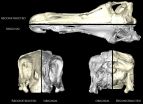(Press-News.org) SALT LAKE CITY, Nov. 5, 2014 – University of Utah engineers developed the first room-temperature fuel cell that uses enzymes to help jet fuel produce electricity without needing to ignite the fuel. These new fuel cells can be used to power portable electronics, off-grid power and sensors.
A study of the new cells appears online today in the American Chemical Society journal ACS Catalysis.
Fuel cells convert energy into electricity through a chemical reaction between a fuel and an oxygen-rich source such as air. If a continuous flow of fuel is provided, a fuel cell can generate electricity cleanly and cheaply. While batteries are used commonly to power electric cars and generators, fuel cells also now serve as power generators in some buildings, or to power fuel-cell vehicles such as prototype hydrogen-powered cars.
"The major advance in this research is the ability to use Jet Propellant-8 directly in a fuel cell without having to remove sulfur impurities or operate at very high temperature," says the study's senior author, Shelley Minteer, a University of Utah professor of materials science and engineering, and also chemistry. "This work shows that JP-8 and probably others can be used as fuels for low-temperature fuel cells with the right catalysts." Catalysts are chemicals that speed reactions between other chemicals.
In the new study, the University of Utah team investigated Jet Propellant-8 or JP-8, a kerosene-based jet fuel that is used by the U.S. military in extreme conditions such as scorching deserts or subzero temperatures.
Converting this jet fuel into electricity is difficult using standard techniques because jet fuel contains sulfur, which can impair metal catalysts used to oxidize fuel in traditional fuel cells. The conversion process is also inefficient, with only 30 percent of the fuel converted to electricity under the best conditions.
To overcome these constraints, the Utah researchers used JP-8 in an enzymatic fuel cell, which uses JP-8 for fuel and enzymes as catalysts. Enzymes are proteins that can act as catalysts by speeding up chemical reactions. These fuel cells can operate at room temperature and can tolerate sulfur.
An enzyme "cascade" of two enzymes – alkane monooxygenase and alcohol oxidase – was used to catalyze JP-8. Hexane and octane, which are chemically similar to JP-8, also were tested as fuels. The researchers found that adding sulfur to their enzymatic fuel cell did not reduce power production.
"Enzymatic fuel cells are a newer type of fuel cell, so they are not currently on the market," says Minteer, also a professor with USTAR, the Utah Science Technology and Research economic development initiative. "However, researchers haven't been able to use JP-8 before, because they haven't had the enzymes to be able to oxidize JP-8."
Solid-oxide fuel cells at temperatures above 950 degrees Fahrenheit have made use of JP-8, but this is the first demonstration at room temperature, Minteer says. Now that the team has shown the enzyme catalysts works, they will focus on designing the fuel cell and improving its efficiency, she adds.
INFORMATION:
Minteer conducted the study with University of Utah postdoctoral researchers Michelle Rasmussen and Mary Arugula, and with Yevgenia Ulyanova, Erica Pinchon, Ulf Lindstrom and Sameer Singhal of CFD Research Corp. in Huntsville, Alabama.
This research was funded by Northrop Grumman Corp. and the National Science Foundation through the University of Utah's Materials Research Science and Engineering Center.
University of Utah College of Engineering
72 S. Central Campus Dr., Room 1650 WEB, Salt Lake City, UT 84112
801-581-6911 fax: 801-581-8692
coe.utah.edu
Jet-fueled electricity at room temperature
University of Utah Engineers create fuel cell that can run without high heat
2014-11-05
ELSE PRESS RELEASES FROM THIS DATE:
Turning pretty penstemon flowers from blue to red
2014-11-05
While roses are red, and violets are blue, how exactly do flower colors change?
In the case of penstemons, with over 200 species to choose from, scientists Carolyn Wessinger and Mark Rausher have now shown that turning their flowers from blue to red involves knocking out the activity of just a single enzyme involved in the production of blue floral pigments.
A genetically conserved biochemical pathway produces the vivid blue pigments that they found to mutate over time to produce red. To shift into red pigment production, the enzyme flavonoid 3', 5' –hydroxylase ...
Patients with emergency-diagnosed lung cancer report barriers to seeing their GP
2014-11-05
MANY patients whose lung cancer is diagnosed as an emergency in hospital reported difficulties in previously seeing their GP, according to research presented at the National Cancer Research Institute (NCRI) Cancer Conference in Liverpool today (Tuesday).
The study, carried out by researchers from the London Cancer Alliance (LCA) and King's College London, investigated around 130 patients who were diagnosed with lung cancer after attending as an emergency at one of seven hospitals in south and west London.
Overall, nearly half of the patients reported that something ...
Scientists uncover potential drug to tackle 'undruggable' fault in third of cancers
2014-11-05
SCIENTISTS have found a possible way to halt one of the most common faults in many types of cancer, according to research presented at the National Cancer Research Institute (NCRI) Cancer Conference in Liverpool today (Wednesday).
A team of scientists at the Max Planck Institute of Molecular Physiology in Germany has
uncovered a new strategy and new potential drug to target an important signalling protein in cells called Ras, which is faulty in a third of cancers.
When the Ras protein travels from the centre of a cell to the cell membrane, it becomes 'switched on' ...
Trial results reveal first targeted treatment to boost survival for oesophageal cancer
2014-11-05
PATIENTS with a specific type of oesophageal cancer survived longer when they were given the latest lung cancer drug, according to trial results being presented at the National Cancer Research Institute (NCRI) Cancer Conference today (Wednesday).
Up to one in six patients with oesophageal cancer were found to have EGFR duplication in their tumour cells and taking the drug gefitinib, which targets this fault, boosted their survival by up to six months, and sometimes beyond.
This is the first treatment for advanced oesophageal cancer shown to improve survival in patients ...
Gene 'switches' could predict when breast cancers will spread to the brain
2014-11-05
SCIENTISTS have found a pattern of genetic 'switches' – chemical marks that turn genes on or off - that are linked to breast cancer's spread to the brain, according to research* presented at the National Cancer Research Institute Cancer Conference in Liverpool today (Wednesday).
The researchers, based at the University of Wolverhampton, studied 24 breast cancers that had spread to the brain, along with samples from the original breast tumour, and found a handful of genes with faulty switches.
Crucially, two of the genetic switches became faulty early on in the ...
New insight into the neuroscience of choking under pressure
2014-11-05
Everyone knows the scene: a basketball player at the free throw line, bouncing the ball as he concentrates on the basket. It's a tight game, and his team needs this point. He regularly makes baskets from much farther away while avoiding defenders, but now, when all is calm, he chokes and misses the basket, and his team loses. Recent research from The Johns Hopkins University suggests that in situations like this, performance depends on two factors: the framing of the incentive in terms of a loss or a gain, and a person's aversion to loss.
"We can measure someone's loss ...
Oxytocin levels in blood, cerebrospinal fluid are linked, Stanford study finds
2014-11-04
For years, scientists have debated how best to assess brain levels of oxytocin, a hormone implicated in social behaviors. Now, researchers at the Stanford University School of Medicine have found the first direct evidence in children that blood oxytocin measurements are tightly linked to levels of oxytocin in cerebrospinal fluid, which bathes the brain.
Low oxytocin levels in blood and CSF are both correlated to high anxiety levels, the research also showed. The findings will be published online Nov. 4 in Molecular Psychiatry.
"So many psychiatric disorders involve ...
Digital dinosaurs: New research employs high-end technology to restore dinosaur fossil
2014-11-04
Fossils are usually deformed or incompletely preserved when they are found, after sometimes millions of years of fossilization processes. Consequently, fossils have to be studied very carefully to avoid damage, and are sometimes they are difficult to access, as they might be located in remote museum collections. An international team of scientists, led by Dr. Stephan Lautenschlager from the University of Bristol now solved some of these problems by using modern computer technology, as described in a recent issue of the Journal of Vertebrate Paleontology.
The team consisting ...
Nonobstructive CAD associated with increased risk of heart attack, death
2014-11-04
In a study that included nearly 38,000 patients, those diagnosed with nonobstructive coronary artery disease (CAD) had a significantly increased risk of heart attack or death one year after diagnosis, according to a study in the November 5 issue of JAMA.
Nonobstructive coronary artery disease (CAD) is atherosclerotic plaque that would not be expected to obstruct blood flow or result in anginal symptoms (such as chest pain). Although such lesions are relatively common, occurring in 10 percent to 25 percent of patients undergoing coronary angiography, their presence has ...
Combination treatment for metastatic melanoma results in longer overall survival
2014-11-04
Among patients with metastatic melanoma, treatment with a combination of the drugs sargramostim plus ipilimumab, compared with ipilimumab alone, resulted in longer overall survival and lower toxicity, but no difference in progression-free survival, according to a study in the November 5 issue of JAMA.
F. Stephen Hodi, M.D., of the Dana-Farber Cancer Institute, Boston, and colleagues conducted a phase 2 clinical trial in which 245 patients with unresectable (unable to be removed by surgery) stage Ill or IV melanoma were randomly assigned to receive ipilimumab (intravenously) ...
LAST 30 PRESS RELEASES:
First ‘Bible map’ published 500 years ago still influences how we think about borders
Why metabolism matters in Fanconi anemia
Caribbean rainfall driven by shifting long-term patterns in the Atlantic high-pressure system, study finds
Potential treatment to bypass resistance in deadly childhood cancer
RSV vaccines could offer protection against asthma
Group 13 elements: the lucky number for sustainable redox agents?
Africa’s forests have switched from absorbing to emitting carbon, new study finds
Scientists develop plastics that can break down, tackling pollution
What is that dog taking? CBD supplements could make dogs less aggressive over time, study finds
Reducing human effort in rating software
Robots that rethink: A SMU project on self-adaptive embodied AI
Collaborating for improved governance
The 'black box' of nursing talent’s ebb and flow
Leading global tax research from Singapore: The strategic partnership between SMU and the Tax Academy of Singapore
SMU and South Korea to create seminal AI deepfake detection tool
Strengthening international scientific collaboration: Diamond to host SESAME delegation from Jordan
Air pollution may reduce health benefits of exercise
Ancient DNA reveals a North African origin and late dispersal of domestic cats
Inhibiting a master regulator of aging regenerates joint cartilage in mice
Metronome-trained monkeys can tap to the beat of human music
Platform-independent experiment shows tweaking X’s feed can alter political attitudes
Satellite data reveal the seasonal dynamics and vulnerabilities of Earth’s glaciers
Social media research tool can lower political temperature. It could also lead to more user control over algorithms.
Bird flu viruses are resistant to fever, making them a major threat to humans
Study: New protocol for Treg expansion uses targeted immunotherapy to reduce transplant complications
Psychology: Instagram users overestimate social media addiction
Climate change: Major droughts linked to ancient Indus Valley Civilization’s collapse
Hematological and biochemical serum markers in breast cancer: Diagnostic, therapeutic, and prognostic significance
Towards integrated data model for next-generation bridge maintenance
Pusan National University researchers identify potential new second-line option for advanced biliary tract cancer
[Press-News.org] Jet-fueled electricity at room temperatureUniversity of Utah Engineers create fuel cell that can run without high heat


